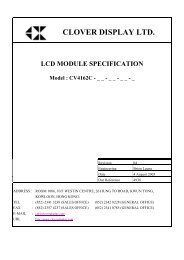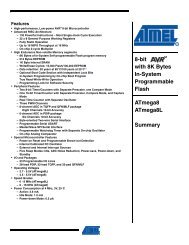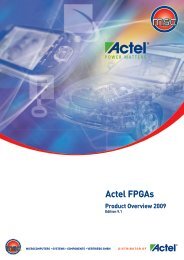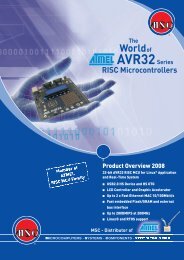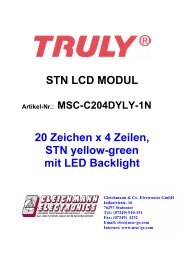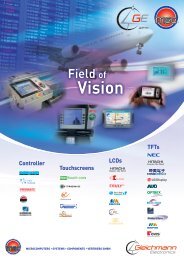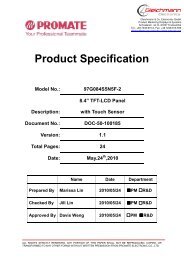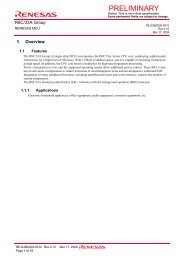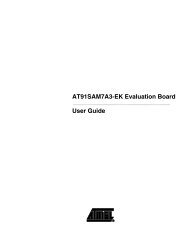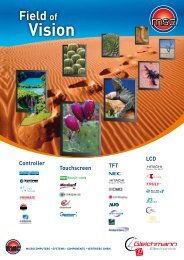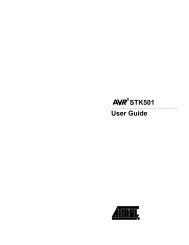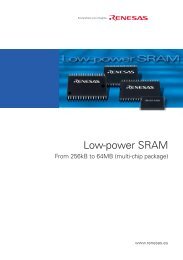SL811HS Embedded USB Host/Slave Controller
SL811HS Embedded USB Host/Slave Controller
SL811HS Embedded USB Host/Slave Controller
Create successful ePaper yourself
Turn your PDF publications into a flip-book with our unique Google optimized e-Paper software.
<strong>SL811HS</strong><br />
Data Port, Microprocessor Interface<br />
The <strong>SL811HS</strong> microprocessor interface provides an 8-bit<br />
bidirectional data path along with appropriate control lines to<br />
interface to external processors or controllers. Programmed<br />
I/O or memory mapped I/O designs are supported through the<br />
8-bit interface, chip select, read and write input strobes, and a<br />
single address line, A0.<br />
Access to memory and control register space is a simple two<br />
step process, requiring an address Write with A0 = ’0’, followed<br />
by a register/memory Read or Write cycle with address line A0<br />
= ’1’.<br />
In addition, a DMA bidirectional interface in slave mode is<br />
available with handshake signals such as nDRQ, nDACK,<br />
nWR, nRD, nCS and INTRQ.<br />
The <strong>SL811HS</strong> WRITE or READ operation terminates when<br />
either nWR or nCS goes inactive. For devices interfacing to<br />
the <strong>SL811HS</strong> that deactivate the Chip Select nCS before the<br />
Write nWR, the data hold timing must be measured from the<br />
nCS and will be the same value as specified. Therefore, both<br />
Intel ® - and Motorola-type CPUs work easily with the <strong>SL811HS</strong><br />
without any external glue logic requirements.<br />
DMA <strong>Controller</strong> (slave mode only)<br />
In applications that require transfers of large amounts of data<br />
such as scanner interfaces, the <strong>SL811HS</strong> provides a DMA interface.<br />
This interface supports DMA READ or WRITE transfers<br />
to the <strong>SL811HS</strong> internal RAM buffer, it is done through the<br />
microprocessor data bus via two control lines (nDRQ - Data<br />
Request and nDACK - Data Acknowledge), along with the<br />
nWR line and controls the data flow into the <strong>SL811HS</strong>. The<br />
<strong>SL811HS</strong> has a count register that allows selection of programmable<br />
block sizes for DMA transfer. The control signals,<br />
both nDRQ and nDACK, are designed for compatibility with<br />
standard DMA interfaces.<br />
Interrupt <strong>Controller</strong><br />
The <strong>SL811HS</strong> interrupt controller provides a single output<br />
signal (INTRQ) that is activated by a number of programmable<br />
events that may occur as result of <strong>USB</strong> activity. Control and<br />
status registers are provided to allow the user to select single<br />
or multiple events, which generate an interrupt (assert INTRQ)<br />
and let the user view interrupt status. The interrupts are<br />
cleared by writing to the Interrupt Status Register.<br />
Buffer Memory<br />
The <strong>SL811HS</strong> contains 256 bytes of internal memory used for<br />
<strong>USB</strong> data buffers, control registers, and status registers. When<br />
in master mode (host mode), the memory is defined where the<br />
first 16 bytes are registers and the remaining 240 bytes are<br />
used for <strong>USB</strong> data buffers. When in slave mode (peripheral<br />
mode), the first 64 bytes are used for the four endpoint control<br />
and status registers along with the various other registers. This<br />
leaves 192 bytes of endpoint buffer space for <strong>USB</strong> data<br />
transfers.<br />
Access to the registers and data memory is through the 8-bit<br />
external microprocessor data bus, in either indexed or direct<br />
addressing. Indexed mode uses the Auto Address Increment<br />
mode described in Auto Address Increment Mode, where<br />
direct addressing is used to READ/WRITE to an individual<br />
address.<br />
<strong>USB</strong> transactions are automatically routed to the memory<br />
buffer that is configured for that transfer. Control registers are<br />
provided so that pointers and block sizes in buffer memory are<br />
determined and allocated.<br />
16 bytes 0x00 – 0x0F Control<br />
0x00 – 0x39<br />
and status registers 64 bytes Control/status registers<br />
and endpoint<br />
control/status registers<br />
240 bytes<br />
0x10 – 0xFF<br />
<strong>USB</strong> data buffer<br />
<strong>Host</strong> Mode Memory Map<br />
Figure 1. Memory Map<br />
192 bytes<br />
0x40 – 0xFF<br />
<strong>USB</strong> data buffer<br />
Peripheral Mode Memory Map<br />
Auto Address Increment Mode<br />
The <strong>SL811HS</strong> supports auto increment mode to reduce READ<br />
and WRITE memory cycles. In this mode, the microcontroller<br />
needs to set up the address only once. Whenever any subsequent<br />
DATA is accessed, the internal address counter advances<br />
to the next address location.<br />
Auto Address Increment Example. To fill the data buffer<br />
that is configured for address 10h, follow these steps:<br />
1. Write 10h to <strong>SL811HS</strong> with A0 LOW. This sets the memory<br />
address that is used for the next operation.<br />
2. Write the first data byte into address 10h by doing a write<br />
operation with A0 HIGH. An example is a Get Descriptor;<br />
the first byte that is sent to the device is 80h<br />
(bmRequestType) so you would write 80h to address 10h.<br />
3. Now the internal RAM address pointer is set to 11h. So, by<br />
doing another write with A0 HIGH, RAM address location<br />
11h is written with the data. Continuing with the Get<br />
Descriptor example, a 06h is written to address 11h for the<br />
bRequest value.<br />
4. Repeat Step 3 until all the required bytes are written as<br />
necessary for a transfer. If auto-increment is not used, you<br />
write the address value each time before writing the data<br />
as shown in Step 1.<br />
The advantage of auto address increment mode is that it<br />
reduces the number of required <strong>SL811HS</strong> memory<br />
READ/WRITE cycles to move data to/from the device. For<br />
example, transferring 64 bytes of data to/from <strong>SL811HS</strong>, using<br />
auto increment mode, reduces the number of cycles to 1<br />
address WRITE and 64 READ/WRITE data cycles, compared<br />
to 64 address writes and 64 data cycles for random access.<br />
Document 38-08008 Rev. *D Page 2 of 32<br />
[+] Feedback



